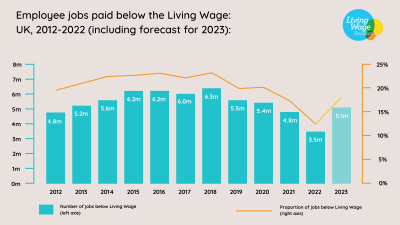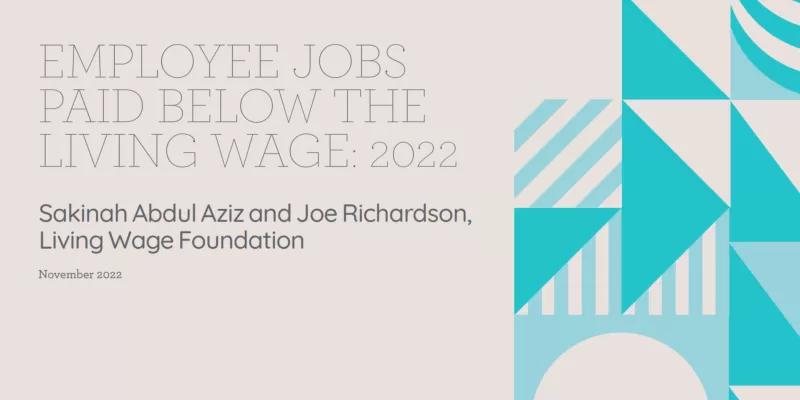- According to new research from the Living Wage Foundation, 3.5 million UK jobs are currently paid below the real Living Wage, the lowest level in over 10 years.
- However, with wages lagging behind inflation, the Living Wage Foundation’s forecasts indicate that this is a “lull before the storm”, with the figure estimated to jump to 5.1 million next year.
- The real Living Wage, as set by the Living Wage Foundation, is the only wage rate based on the cost of living. It is currently £10.90 in the UK and a higher rate of £11.95 in London.
- Over 11,000 UK businesses are accredited with the Living Wage Foundation, including Aviva, Everton FC, Burberry, IKEA, LUSH and Nationwide.
New research by the Living Wage Foundation demonstrates that, despite the number of workers earning below the real Living Wage standing at the lowest it has been in 10 years (3.5 million), this is a ‘lull before the storm’ with the number of jobs paying below the real Living Wage forecast to jump to 5.1 million next year as wages continue to lag behind inflation amid the cost-of-living-crisis.
According to the latest analysis of the Annual Survey of Hours and Earnings (ASHE) from the Office for National Statistics (ONS), 1 in 8 workers in the UK are earning less than the real Living Wage. This equates to 12.2% of all employee jobs and a total of 3.5 million.
This is the largest drop in a single year, with the number of workers earning below the real Living Wage falling by 4.9 percentage points since April 2021, when 4.8 million workers were paid below the Living Wage. According to the data, this is the lowest the figure has been in 10 years.
However, while the statistics appear positive, new research by the Living Wage Foundation published today forecasts this drop in low paid jobs is set to bounce back next year, with the number of workers earning below the real Living Wage now forecast to jump up to 5.1 million (1 in 5 jobs).

The real Living Wage is the only wage rate calculated based on what people need to live on. It currently stands at £10.90 (UK) and £11.95 (London). For a full time worker, that represents £2,730 more than someone earning the government’s National Living Wage. A worker on the London Living Wage would be almost £5,000 better off than someone on the National Living Wage.
Over 11,000 UK businesses are accredited with the Living Wage Foundation, including Aviva, Everton FC and LUSH, as well as thousands of small-to-medium sized businesses. 370,000 UK workers receive an annual pay rise to the real Living Wage rates because of their commitment to always paying the real Living Wage.
Katherine Chapman, Director of the Living Wage Foundation, said:
“The campaign for a real Living Wage has had a huge impact on tackling in work poverty, with over 370,000 workers now receiving an annual pay rise thanks to the commitment of 11,000 UK employers. However, while this year’s data on low paid jobs appears positive, our forecasts demonstrate a bleak picture for next year, with an estimated 5.1 million workers set to be paid below the real Living Wage. With the cost of living rising and families facing more pressure this winter, it has never been more important for businesses do the right thing and commit to paying a real Living Wage.”
Rosie Fogden, Head of Research and Analysis at the Centre for Progressive Policy, said:
“Based on actual living costs, the real Living Wage is a really important measure of the extent to which work is paying people enough to live on. We have seen the price of household staples like bread and pasta rise by as much as 60% over the last year and this fast changing economic context gives the real Living Wage renewed significance as businesses and local policymakers look for ways to support their communities.
In certain places across the country, like Rossendale, Boston and West Devon, low paid jobs dominate the labour market, restricting opportunities for those that live there and leaving them vulnerable to poverty as well as holding back regional productivity.
Paying the real Living Wage in these places can help to ensure the workforce benefits from economic growth in their area. In response to the current crisis, the Centre for Progressive Policy has also proposed a new locally delivered Business Transition Fund to support the transition of energy-intensive sectors to a decarbonised economy and protect employees.”
Employee jobs paid below the Living Wage 2022
This report reveals the total number of below Living Wage jobs in the UK, compared with previous years.

Media contacts:
Living Wage Foundation media contacts: Matt.ford@Livingwage.org.uk / emily.roe@Livingwage.org.uk – 07581430557
Living Wage Foundation Research Contacts for questions on the data: joe.richardson@livingwage.org.uk – 07740186651
Living Wage Week, from Monday 14th November 2022, is a UK-wide annual celebration of the 11,000 UK businesses who have voluntarily committed to ensure employees and sub-contracted staff earn a real Living Wage. This includes half the FTSE 100 and major household names such as Everton FC, Burberry, Aviva, Nationwide.
What is the real Living Wage?
The real Living Wage is an hourly rate of pay set independently and updated annually (not the UK government’s National Living Wage). It is calculated according to the basic cost of living in the UK, and employers choose to pay the Living Wage on a voluntary basis. According to the Living Wage Foundation, since 2011 the campaign has impacted over 370,000 employees and delivered over £3bn extra to some of the lowest paid workers in the UK.
About the Living Wage Foundation
The Living Wage Foundation is the institution at the heart of the independent movement of businesses, organisations and people who believe that a hard day’s work should mean a fair day’s pay. We recognise and celebrate the leadership shown by the over 11,000 Living Wage Employers across the UK who voluntarily commit to ensure their staff earn a real Living Wage that meets the cost of living. We are an initiative of Citizens UK.
Only the real Living Wage is calculated according to the cost of living in the UK and in London. Employers choose to pay this wage on a voluntary basis. The real Living Wage applies to all workers over 18 – in recognition that young people face the same living costs as everyone else. It enjoys cross party support.
Notes on data:
Data on the proportion and number of jobs paid below the Living Wage comes from the Annual Survey of Hours and Earnings (ASHE). Carried out in April each year, ASHE is the most comprehensive source of information on the structure and distribution of earnings and hours worked among employees in the UK. ASHE is based on a 1 per cent sample of employee jobs taken from HM Revenue & Customs (HMRC) Pay As You Earn (PAYE) records.
To forecast the scale of below Living Wage pay next year, we have applied the newly announced Living Wage rates and recent projections for wage growth (using Bank of England and Treasury projections), to this year to the ASHE data, adjusted across the earnings distribution for differential wage growth seen in recent PAYE-RTI data and expectations for next year's minimum wage increase.
